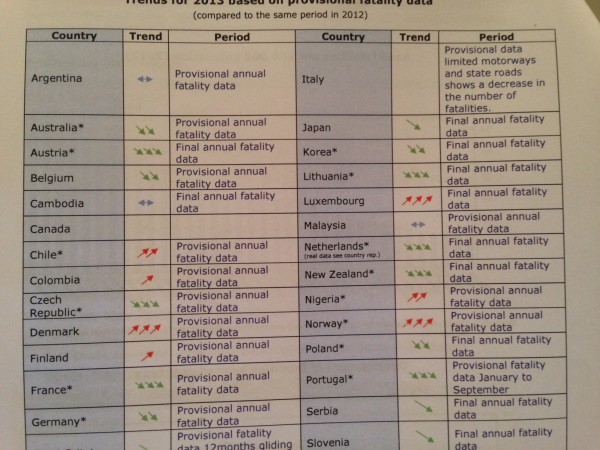EDITOR’S NOTE: Spacing senior editor Shawn Micallef is in Germany this week attending the International Transport Forum. He’ll report throughout the week on workshops and seminars.
LEIPZIG, GERMANY — I’m here at the International Transport Forum in Leipzig, Germany, on assignment for Spacing. The latest road safety annual report was released by the International Traffic Safety Data and Analysis Group this morning; you can get the summary report here (pdf) or the full report here (pdf).
Overall the group found that road fatalities fell between 2011 and 2012 by 1.7% in the 31 participating countries, though it isn’t improving for the most vulnerable users (pedestrians, cyclists and motorcyclists). With cyclists the stagnant fatality rating is partially due to more people cycling, leading to more crashes. An interesting proposal that the group is working on is a kind of rating system for roads based on how dangerous they are, much how car makes have standardized safety ratings. In Canadian cities we tend to base our idea of how dangerous a road is by yearly “most crashes by intersection” stories, which are certainly valuable information, but a rating on the type of road, with, say, busy one-way arterial roads in city centre’s getting a poor rating, could lead to a wider rejection of certain kinds of roads (or political will to fix them) then they are simply deemed entirely dangerous.
You can get a sense of some of the trends in this chart from the summary report. I asked about why Canada was conspicuously blank (warily, given our county’s aversion to data sometimes) but was told because transportation stats are collected by province here, they hadn’t been all collected in time.
Over on Twitter I’m chirping out updates as I see them as well.




One comment
This seems akin to our “leadership” on climate change; except at least we’re somewhat aware of the data and it forms the basis for some justified criticisms. But that data – at least for cycling in TO – really doesn’t translate into any real on-street change for cyclists, as there’s been 30 years of crash data showing a consistent pattern of harm and crash on the east-west roads of the core, but we do not have too much change especially west of Bathurst St. I’m excessively negative from the Bloor bike lane file, where we’re now back to where we were 8 or 9 years ago with a bold study of bike lanes in the core 8kms, and in the meanwhile, gee, the road is being repaved but for status quo car travel, even though it’s parallel to the subway, tons of parking atop it, and we could ease the crush of the subway for the price of paint for a good bikeway. Bloor lanes are needed especially W of Ossington where Harbord ends.
The status quo repaving of Bloor is also contrary to 3.2.2 and 3.2.3 of the Places to Grow Act, as it seems to mandate an improvement in biking conditions etc., with ordinary maintenance. The City, and this often seems to include the progressives and a few of the advocates, seem to be quite OK with dangerous sheiss, and doing nothing but maybe rebuilding a few existing bike lanes. The pilot for Richmond/Adelaide? – some progress – but R/A was in the Bike Plan a full 12 years ago…